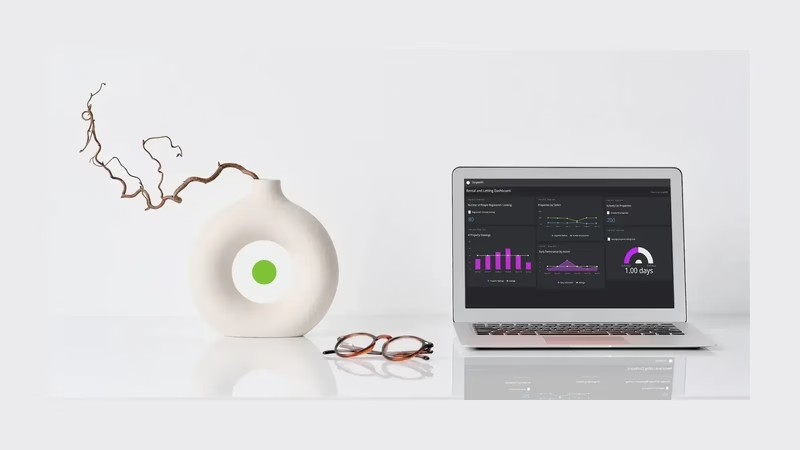Boutique hotels have become immensely popular over the past decade due to their unique and personalized experience, intimate atmosphere, and alluring charm that larger hotels arguably struggle to offer.
Furthermore, the growth of short-term rental businesses, according to AirDNA's 2023 Forecast reached an astonishing 100 billion alone in the US, fueled by a 21% increase in demand. The integration of simple-to-set-up and operate platforms such as Airbnb and VRBO have enabled those with limited hospitality knowledge to provide accommodation services.
Individual owners face more significant challenges as the hotel industry shifts from traditional to more independent operators. From cleaning and maintenance to managing finances, virtually all aspects of running a hotel are now in the hands of these individuals.
In the following article, we will explore:
- Why should boutique and short-term rental businesses track KPIs?
- What are the most important KPIs for boutique hotels?
- How are Boutique Hotel KPIs tracked?
- Conclusion
Why should boutique and short-term rental businesses track KPIs?
KPIs (Key Performance Indicators) are an essential tool for Boutique Hotel owners and managers to track their business performance. They provide a holistic overview of the current state of operations, allowing owners and managers to take corrective action if needed. Understanding which KPIs are most important can help Boutique Hotel owners and managers prioritize their attention and resources.
Utilizing a KPI strategy is the perfect solution for small business owners facing numerous challenges when it comes to accelerating revenue.
What are the most important KPIs for boutique hotels?
The most important Boutique Hotel KPIs to monitor include Average Daily Rate (ADR), RevPAR, Occupancy Rate, Labor Costs as a Percentage of Operating Expenses, Customer Satisfaction, EBITDA, Social Media, Revenue Per Channel.
-
Average Daily Rate (ADR)
ADR is a metric used in the boutique hotel industry for revenue management. It offers hotel owners an acute insight into their current performance. By revealing the daily average rental income of occupied rooms, ADR serves as a valuable benchmark that can be compared to other hotels with similar characteristics. This knowledge allows them to adjust their business strategies accordingly and maximize profits.
Why do Hotels use ADR?
By assessing their ADR, hotel owners can measure themselves against other hotels as well as past performance to optimize their revenue management strategy. Unlike most metrics that assess the entire income earned by a hotel, however, ADR does not take into account complimentary rooms or any free-of-charge services provided - so make sure you factor this out of your calculations.
How is ADR calculated?
ADR is calculated by dividing the total rental income of all occupied rooms by the number of those rooms. This calculation should be made per day to gain an accurate representation of performance, as this allows hotel owners to measure their ADR on both a short-term and long-term basis.
-
Revenue Per Available Room (RevPAR)
In the STR industry, Revenue per available room (RevPAR) is an essential metric for hotel performance. It gives hotel owners insight into their current capacity and the overall demand for hotel services.
Why do accommodation businesses use RevPAR?
By assessing their RevPAR, hotel owners can measure the average revenue earned per room daily. This is essential for revenue management and allows hotel owners to adjust their pricing strategies and maximize profits.
Limitations
RevPAR is an ideal benchmarking metric but does not consider the size of the business; it allows hotels to review their performance over time.
Boutique hotels can also compare against other establishments in the region to gain insight into their performance relative to competitors. With this information, hotels can take proactive steps towards adjusting prices and amenities based on customer preferences or seasonal demand alterations.
How is RevPAR calculated?
There are two common approaches to calculating RevPAR:
This first is obtained by multiplying Average Daily Room Rate (ADR) and Occupancy rate together.
RevPAR = Average Daily Rate * Occupancy RateAlternatively, it can be found by dividing Total Room Revenue from a specific period by the number of Available Rooms in that same timeframe.
RevPAR = Total Revenue / Number of Rooms Available -
Occupancy rate
Occupancy Rate helps hotel owners understand how efficiently their available space is being utilized.
A reasonable Occupancy Rate for Boutique Hotels is typically around 70%. Boutique hotels usually have higher occupancy rates than larger ones, as their size and amenities often make them desirable for a range of customers.
Why do boutique hotels monitor occupancy rates?
By understanding their occupancy rates, boutique hotel owners can better gauge customer preferences, adjust prices accordingly, and maximize profits.
How is the occupancy rate calculated?
It’s calculated by dividing the number of rooms occupied in a given period by the total number of rooms available for rent.
Total occupied rooms / Total Available Rooms -
Labor costs as a percentage of operating expenses
Boutique hotels need to be aware of their labor costs to keep them under control and ensure efficiency. Labor cost analysis allows Boutique hotel owners to become more mindful of where their money is going and helps them make strategic decisions around staffing levels and wages.
How is Labor costs as a percentage of operating expenses calculated?
The formula for calculating Labor costs as a percentage of operating expenses is:
Total Labor Costs / Operating Expenses * 100%The number of hours spent on operating the accommodation business can easily be determined by calculating an owner's salary relative to a predetermined wage, helping them measure their Key Performance Indicator (KPI).
-
Customer satisfaction
The hospitality industry stands and falls on customer satisfaction – it is the ultimate measure of success or failure in this sector. For smaller businesses like boutique hotels and rental owners, who have limited rooms available, any negative customer feedback can be especially damaging to their reputation.
Why do boutique hotels monitor customer satisfaction?
Boutique hotels need to monitor customer satisfaction to gain insight into their guests' experience and how they can improve it. Tracking customer feedback allows Boutique Hotels to pinpoint areas of improvement, such as staff training, food quality, cleanliness, or service times.
How is Customer Satisfaction monitored?
There are several ways to track customer service, and they can be broken down into many categories, such as service, food standard, comfort, etc. However, as smaller businesses are time-limited, it is better to focus on an overall satisfaction score (normally 1 - 5) while also allowing the client to add their thoughts on your service.
The most common is through the use of surveys. Boutique hotels can send out surveys to guests after their stay, this can be automated via apps such as Survey Sparrow, Qualtrics, or SurveyMonkey.
Another way to track customer satisfaction is through online reviews, such as those on TripAdvisor or Google.
More Resources:
https://www.getfeedback.com/resources/csat/how-to-measure-customer-satisfaction-kpis/
-
EBITDA (Earnings Before Interest, Taxes, Depreciation, Amortization)
EBITDA is a key performance indicator (KPI) used to measure the financial performance of Boutique Hotels. This metric looks at profits before interest and taxes are accounted for.
Why do Boutique hotels track EBITDA?
EBITDA is meaningful for Boutique hotels to track because it gives them a better idea of their profitability and cash flow. This KPI provides a more accurate assessment of the financial health of Boutique Hotels, as it accounts for significant expenses like depreciation and amortization, which often do not show up on traditional financial statements.
How to calculate EBITDA
EBITDA is calculated by subtracting costs of goods sold, operating expenses, taxes, and depreciation from the Boutique Hotel's gross income. The formula looks like this:
EBITDA = Gross Income – (COGS + Operating Expenses + Taxes + Depreciation) -
Social Media Engagement
Social media KPIs are metrics used to establish if a Boutique hotels social media marketing strategy is effective. In a nutshell, these are the analytical data associated with different social media platforms such as Facebook, Twitter, or Instagram.
Why Boutique Hotels track Social Media Engagement
Social media engagement is one of the top ways Boutique hotels can connect with customers and potential guests. The more engaged followers Boutique Hotels have on social media, the more likely people will interact with their posts and services. Boutique hotels can use social media engagement metrics to measure the success of their campaigns, track ROI, and obtain insights into consumer behavior.
How Boutique Hotels Track Social Media Engagement
There are a few key metrics Boutique Hotels should be tracking when it comes to social media engagement. These include likes, comments, shares, retweets, and impressions. Boutique Hotels should also track the number of followers they have on each platform and how often their posts are being interacted with. Moreover, Boutique Hotels can keep an eye on sentiment analysis – the overall sentiment associated with the content they post. This will provide Boutique Hotels with insight into how their guests perceive their content and the overall quality of their services.
-
Revenue Per Channel
For rental property owners who utilize external sites such as Airbnb, VRBO, and Booking.com, in addition to direct booking websites, monitoring the financial return from each channel is of utmost importance.
How is Revenue per Channel Tracked?
Revenue per channel can be tracked via an online booking system or other software that provides detailed analytics. Boutique Hotels can monitor which channels are providing the most revenue and use this information to optimize their strategies for each platform.
With so many rental booking channels available, manually combining data can be a laborious task. Fortunately, you can simplify and save time by automating the data into one unified KPI Dashboard - allowing you to focus on operating your business.
How are Boutique Hotel KPIs tracked?
It is essential for Boutique hotel owners and managers to gain insight into their business performance and make informed decisions quickly. This can be achieved by using software such as Excel, KPI Tracking Software such as SimpleKPI or dedicated hotel management applications that offer additional KPI tracking via dashboards, notably Cloudbeds and Hostfully.
Using a single source, like a Dashboard and KPI Reporting system, Boutique hotel managers can simultaneously access their data from multiple sources like websites, booking systems, and other data sources. This allows Boutique Hotels to compare key performance indicators and get a complete overview of the health of their business in one place.
Conclusion
To stay ahead of the competition and reduce costs, owners of boutique and short-term rentals can benefit immensely from utilizing a straightforward key performance indicator (KPI) strategy. This can help them monitor progress while ensuring they remain competitive in an ever-changing market.
By ensuring customer satisfaction, monitoring labor costs, and marketing efficiently and effectively, they can manage the smooth running of their operations.
With the right data points and tracking of these metrics via simple KPI software, Boutique Hotels have the correct information at the right time to make strategic decisions that will drive growth and success.

by Stuart Kinsey
Stuart Kinsey writes on Key Performance Indicators, Dashboards, Marketing, and Business Strategy. He is a co-founder of SimpleKPI and has worked in creative and analytical services for over 25 years. He believes embracing KPIs and visualizing performance is essential for any organization to thrive and grow.
